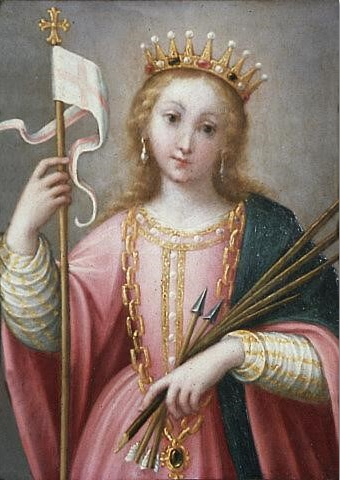St Ursula was a British Catholic Saint who lived and died somewhere between the 3rd and 4th century AD.
Her Feast Day is the 21st of October.
She is the Patron Saint of Young Women.
Because of the age of the account of St. Ursula we can’t be absolutely certain of the historical details; however, many men and women have been inspired by the account you are about to read.
In Britain there lived a Christian King with a daughter named Ursula. She possessed so much dignity, wisdom and beauty that people everywhere talked about her.
The King of Anglia wanted his son to marry her - the Prince also wanted this. They sent messengers to the Christian King promising him many riches if he allowed his daughter to marry the Prince of Anglia.
The messengers also made terrible threats of what might happen if the King did not agree. The King of Anglia was not a Christian King, but a Pagan. Pagans worshiped the created rather than the Creator, wind earth, sea and other things rather than God.
Ursula’s father was very scared by all of this. He felt it wrong to let his daughter be married to a Pagan Prince but also feared the violence that would follow if he didn’t agree.
Ursula, inspired by God advised her Father to let the proposal go ahead, but only on the following conditions:
- Both Kings were to provide her with 10 chosen girls; each of them would be accompanied by another 1000 girls.
- The Kings were also to provide ships for a journey.
She further asked to be given 3 years to dedicate herself to God before she got married. Ursula hoped that this delay of marriage would put off the Prince and he and his Father the King would withdraw their proposal of marriage.
Unbelievably the Prince agreed to these demands, he also asked to be baptised immediately and called for all of Ursula’s orders to be carried out that very day.
Girls from all over the country began to hear of Ursula’s requests and left every part of the land to be part of her journey. All of the girls converted to Christianity and Ursula and her companions pledged an allegiance of protection towards each other.
Ursula and her companions set off for their journey. Ursula had a vision in which she was told to head to Rome. Ursula and her companions headed to Rome where they were met by Pope Cyriacus. Such was the size of Ursula’s group, it had attracted the attention of the Holy Father himself.
That night the Pope held a special meeting with Ursula and her companions and something extraordinary happened.
The Pope was inspired by their faith and commitment to each other and he decided that he would join them. The Pope renounced his title, although everyone objected, especially the Cardinals but he would not change his mind.
The group began their journey home and on the way passed through Cologne in Germany. The local rulers of Cologne at this time, the Huns, were greatly upset at the sight of this large group of Christians. Their strength of faith is said to have frightened them, and they feared that everyone who saw them would want to become a Christian too.
The Huns massacred the thousands of people in Ursula’s group. When the leader of the Huns saw Ursula, he offered to spare her life in return for her hand in marriage, when she refused, he felt insulted and thrust an arrow into her heart. She is said to have asked God to forgive him as she died. St. Ursula is often pictured with an arrow in her hand for this very reason.
St. Ursula isn’t just a story of just another saint. Whatever the truth of what happened to St. Ursula and the thousands that followed her on her journey to know God, the real meaning still shines through.
